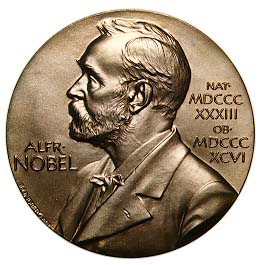 Swedish chemist, inventor and engineer Alfred Nobel held more than 350 patents and owned several companies which created and sold explosives. Still he is best known as the founder of the Nobel Prizes and that is the way he wanted.
Swedish chemist, inventor and engineer Alfred Nobel held more than 350 patents and owned several companies which created and sold explosives. Still he is best known as the founder of the Nobel Prizes and that is the way he wanted.
Alfred Nobel began experimenting with nitroglycerine as an explosive in 1863. These experiments were very dangerous and accidents in the lab led to the deaths of several people including Noble’s younger brother. Because of this the Swedish government banned the experiments inside the city limits of Stockholm. This ban did not deter Nobel. He moved his experiments to a barge on Lake Malaren. In 1864, he began mass production of nitroglycerin.
Nobel wanted to make the explosive safer and he continued with experiments to do so. In 1866, he discovered that mixing nitroglycerin with a fine sand known as kieselguhr turned the liquid into a paste. This paste had much less explosive power than straight nitroglycerin but it was also less susceptible to accidental detonation when shaken or dropped.
In 1867, Nobel patented this mixture. He first considered calling it “Nobel’s Safety Powder” to improve his image after earlier explosions. He decided instead on Dynamite which refers to the Greek word for power.
Nobel’s other inventions included Gelignite and ballistite. Gelignite is an explosive material consisting of collodion-cotton dissolved in nitroglycerine and mixed with wood pulp and saltpeter. Gelignite is easy to mold, safe to handle without protection and cannot explode without a detonator. Ballistite is a smokeless propellant made from two high explosives, nitrocellulose and nitroglycerine. Today, Ballistite is still used as a rocket fuel.
 The founding of the Nobel Prizes came about because of an accident. In 1888, when Nobel’s brother Ludwig died, a French newspaper ran Alfred Nobel’s obituary instead. The newspaper proclaimed that the merchant of death was dead, condemned him for his invention of dynamite and described him as the man who made it possible to kill more people more quickly than ever before. Nobel was understandably horrified and decided to try and change his legacy.
The founding of the Nobel Prizes came about because of an accident. In 1888, when Nobel’s brother Ludwig died, a French newspaper ran Alfred Nobel’s obituary instead. The newspaper proclaimed that the merchant of death was dead, condemned him for his invention of dynamite and described him as the man who made it possible to kill more people more quickly than ever before. Nobel was understandably horrified and decided to try and change his legacy.
In November of 1895, Nobel signed his handwritten last will and testament. This will left a majority of his fortune, 31 million dollars, to a foundation that awards prizes for achievements in physics, chemistry, physiology or medicine, literature and for peace. The prizes are awarded each year on December 10. Each winner receives a gold medallion, a diploma and a monetary prize. The monetary prize for 2010 is 10 million Swedish Kronner which is about 1.45 million US dollars.
The Nobel Prizes succeeded in changing the legacy of Alfred Nobel. His name is no longer synonymous with dynamite, explosives and death. Instead, the name Nobel represents great achievement in many areas including the spread of peace.
